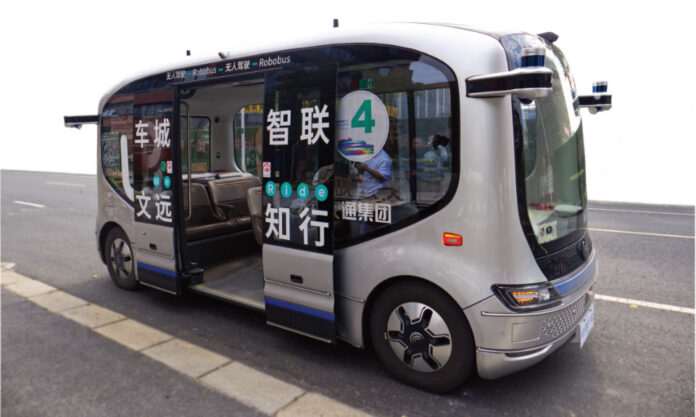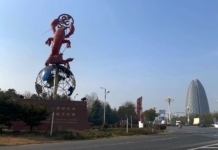Cynics would have you that autonomous vehicles would never work in China; its roads too lawless, their users too reckless or malicious. Likewise for the enormous environmental but futile challenge confronting the planet; that shutting down the internal-combustion engine 30 years ago would have been the preferred option.
The 2023 Internet of Things Exposition took place in Wuxi of Jiangsu from 21-23 October. Outside the exhibition centre was an autonomous shuttle-bus stop. Nothing could have said it plainer.
It was an opportunity too good to pass up, namely checking in on China’s latest developments in the field of fully-autonomous vehicles.
The Nanjinger was on 22 October thence invited to join a somewhat unique experience, along with reporters representing AFP, Korea’s The Segye Times and China’s Xinhua News Agency, among others from Germany, Italy and Japan, in touring the many advances made in Wuxi over the past couple of years.
That all led to the present situation, whereby Wuxi has developed an Internet of Things (IoT) industrial cluster that has added some ¥400 billion to the City’s bottom line in the past year, based on Wuxi’s strong industrial foundations dating back many decades, if not centuries; including today, electronic information and auto parts.
This is a culmination of efforts that began in 2009, when Wuxi got the go ahead to build that termed a “national sensor network innovation demonstration zone”, together with the first national-level Internet of Vehicles pilot zone.
More recently, from 2017-2019, and with the support of the Ministry of Industry and Information Technology, the Ministry of Public Security and Jiangsu Province, Wuxi worked with leading companies such as China Mobile and Huawei to make C-V2X (Cellular-Vehicle 2 Everything) a reality.
That brought us, literally, to get on the bus, an appropriate place to take a metaphorical step back and ask, “What is the IoT?”. First proposed, it is thought, by Kevin Ashton, a professor at MIT, in the 1990s, in our context, it’s where roads literally talk to vehicles.
For us, that meant a WeRide vehicle. Founded down south in Guangzhou in 2017, WeRide established its East China headquarters in Wuxi Economic Development Zone in September of last year.
By October of 2023, over some 300 square kilometres of Wuxi in several parts of the City, there were getting on for 200 autonomous vehicles in operation. In particular, complete coverage has been realised in Wuxi High-tech Industrial Development Zone since March of this year. While many are autonomous vehicles utilised for delivery and other services, there are at present some 50 WeRide buses available for use by the public, in different modes; taxi, bus and scenic spot.
In taxi mode, a bus is hailed just as is done on a ride-hailing platform. Bus mode sees WeRide vehicles join their human-controlled counterparts in making regular stops along a designated route, while scenic spot mode speaks for itself.
On board, the bus is 100-percent 5G controlled and comes equipped with emergency-stop buttons, a fire extinguisher and hammers to break the windows should the need arise.
So off we went. And it worked. Perfectly. The kicker, though, is that all aboard felt safer than if there were to be a human at the controls.
To say that we were taken aback is an enormous understatement. There is no driver behind a steering wheel which might be never touched and neither is the bus segregated from non-autonomous traffic. There is just a tablet-toting WeRide employee, seated at the back of the bus and trying to be inconspicuous, present only on account of government regulations to take over control if necessary.
That’s down to Wuxi’s forming of a relatively-complete system of laws, regulations, policy guarantees and commercial operations, backed by the implementation of local legislation on the Internet of Vehicles.
Said employee is expected to be reassigned and taken off the bus once WeRide can prove itself beyond a shadow of a doubt as to that legislation, maybe within a year.
Even by then though, it’s likely that autonomous buses of this sort will still be a novelty to many and thus, a tempting target for a spot of mischief. But WeRide has taken care of that too. Other road users behaving maliciously toward our bus were simply honked at, to a burst of laughter from all aboard, while video was captured and sent to the local police station. Law enforcement will subsequently identify the individual responsible and bring them in for re-education.
Back at the 2023 World IoT Expo, Xue Ming, Vice President of Huawei’s Business Group and Director of the National Broadband Mobile Communications Core Network Engineering Technology Research Centre, said that the IoT will develop to boast for itself hundreds of billions of nodes in the next 5 to 10 years, creating a multi-trillion renminbi market.
These are also developments that could not have come a moment too soon. Today’s upcoming generations hardly want to drive a bus for a living. And with drivers’ salaries one of the most significant costs for a bus operator, removing them means there can be many more buses on the road, while they also not need be capable of carrying 50 people. Nine seats is a perfect number; the requirement to wear a seatbelt before the bus can operate eliminating standing-room only and stifling, crowded environments.
But much remains to be done and it is evident it needs doing on a hugely-accelerated time scale. The driver of the bus which took our reporting team around the various IoT-related sights put it best, saying, “I’ll be retired long before that thing takes my job”.
It may still be too early to say with confidence that there will be a world left for our children, and their children. Assuming so, however, chances are a big part of that will be down to to this relatively-new concept somewhat incongruously named the Internet of Things.













